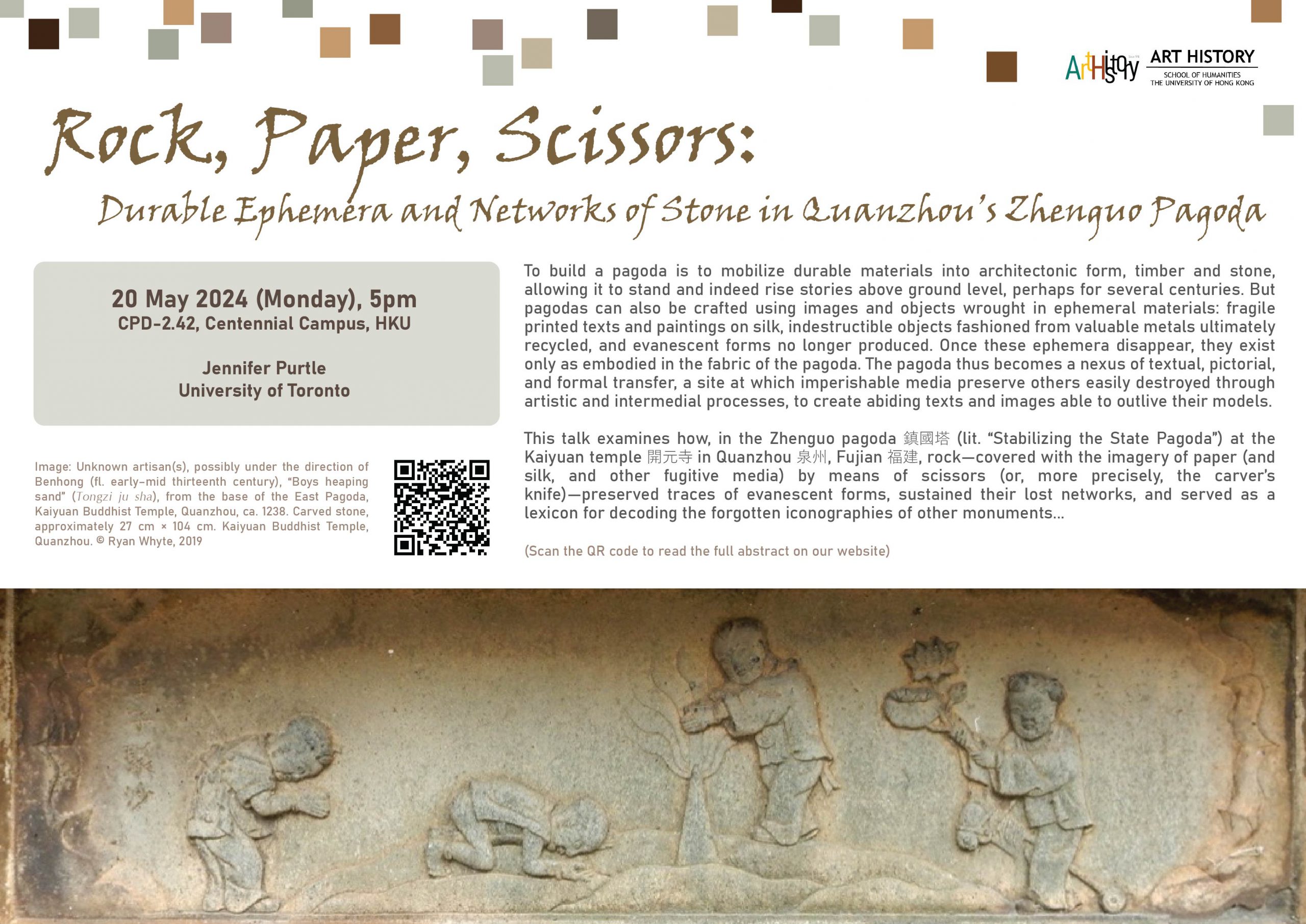

Rock, Paper, Scissors
May 20, 2024 @ 5:00 pm - 6:30 pm
Rock, Paper, Scissors: Durable Ephemera and Networks of Stone in Quanzhou’s Zhenguo Pagoda
Date: 20 May 2024 (Monday)
Time: 5pm
Venue: CPD-2.42, Centennial Campus, HKU
Speaker: Prof. Jennifer Purtle, University of Toronto
Abstract
To build a pagoda is to mobilize durable materials into architectonic form, timber and stone, allowing it to stand and indeed rise stories above ground level, perhaps for several centuries. But pagodas can also be crafted using images and objects wrought in ephemeral materials: fragile printed texts and paintings on silk, indestructible objects fashioned from valuable metals ultimately recycled, and evanescent forms no longer produced. Once these ephemera disappear, they exist only as embodied in the fabric of the pagoda. The pagoda thus becomes a nexus of textual, pictorial, and formal transfer, a site at which imperishable media preserve others easily destroyed through artistic and intermedial processes, to create abiding texts and images able to outlive their models.
This talk examines how, in the Zhenguo pagoda 鎮國塔 (lit. “Stabilizing the State Pagoda”) at the Kaiyuan temple 開元寺 in Quanzhou 泉州, Fujian 福建, rock—covered with the imagery of paper (and silk, and other fugitive media) by means of scissors (or, more precisely, the carver’s knife)—preserved traces of evanescent forms, sustained their lost networks, and served as a lexicon for decoding the forgotten iconographies of other monuments. This talk articulates the relationship of paper-based editions of the Buddhist canon, especially printed ones, to the stone-carved narrative program and demonstrates how single reliefs combine content from multiple sutras; it also asserts that artisans employed the logographic schema of printed-paper primers as well as pictorial styles drawn from court painting on silk, known locally, to maximize the intelligibility of the reliefs. Furthermore, this essay contends that, by representing small, free-standing bronze (and stone) pagodas—their corpus, like those of their paper- and silk-based counterparts, now largely lost—the reliefs establish links to overlapping local (Quanzhou), regional (Min-Yue/Fujian), imperial, and maritime (Indian Ocean) object networks. Finally, by using the durable images of the Zhenguo pagoda as indices of long-lost monuments, this essay recovers the identity of an unusual local type of monument, thereby validating the hypothesis that this pagoda serves as a repository of, and lexicon for, now-lost ephemera.
Speaker
Professor Jennifer Purtle (Chinese name: 裴珍妮) teaches at the University of Toronto. She researches the artistic landscape of China, especially that of Fujian province, engaging questions of local and regional production of painting in relation to Chinese empires. These aspects are central to her forthcoming monograph, The Problem of Place: Artistic Geography and Cultural Transactions in Min [Fujian] Painting, 909–1646. She is also interested in the circulation of art objects in the medieval world system, especially in the Great Mongol Empire and is currently working on a book-length project that traces the intersection of local and global art history in Fujian during the Song and Yuan dynasties.



Find us on…